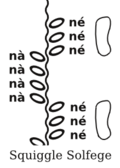Slantnote-bis Intro for Students

The Squiggle–that diagram between the two phrases above, with the footprints–will leap-frog you over the worst beginning difficulties of music reading and music theory. There are many-plenty examples of Slantnote-bis at EarFirst.com for practice on familiar songs. Watchit! the examples link has some files that do NOT use either slantnote or slantmarkup. You have to read the short KEY TO FILE TYPES at the top to decide which ones to download.
Slantnote-bis Intro for Educators

Slantnote notations and markups are based on the squiggle, a vertical alternative to the keyboard for visualizing melodic and harmonic structures. The squiggle and its notations are motivated by weaknesses in conventional notation in the areas of fast sight-singing and of amateur self-education for accurate reading a cappella.
Slantnote-bis on Rails
Slantnote on rails uses a staff of rails: tonic rails and dominant rails only. Rails are key-free moveable in the same sense that “moveable-do” solfeggio is not locked to a specific pitch. Usually they are used in threes, in either authentic or plagal lie. When tonic rails are at bottom and top the arrangement is in authentic lie, with a dominant rail intermediate—4/7 the tonic octave separation above the lower tonic.

The reverse arrangement is plagal lie: dominant rails outermost, with tonic intermediate at 3/7 the octave distance.
Leger lines are likewise dominant or tonic only.

Slantnote-bis on Clefs
Slantnote on clefs uses the well-known 5-line staff with clef sign and key signature, much as on rails. In addition to slanting the noteheads, the 3-2-1 footprint follows immediately after the key signature.
The slant of notes, and the small marks on né-slant notes, can be easily ignored by those who don’t want to use them because they already know how to read in 5-line clefs. On the other hand, bright beginners can note their import and use them to settle the Final Semitone Uncertainty, without tutelage.
Generations of amateur choir members have taught themselves to “almost-read” in clefs, relying on Fickle Dame Memory and someone pounding out the FSU on a piano. This, unfortunately, also teaches that a keyboardist is necessary for rehearsals and that diatonic theory is beyond the reach of those not having studied some instrument.
Further, the practice habituates both choir and accompanist to too-loud performance, destroying the possibility of solid intonation, since that depends on hearing oneself and the ensemble at once.
Slantmarkup
The third squiggle-informed notation, slantmarkup, is the most conservative in respect of usual notation. It is a markup schema that can be retrofitted to existing conventional scores as redundant information in aid to sight-reading precision.

In slantmarkup, first a squiggle footprint outlining the 1-2-3 degrees locates (foots) the diatonic reference on the staff. The squiggle footprint serves as a “key signature decode”. (On “rails”, the footprint tells the mode.)
Once the diatonic pattern is thus footed, a small slant is drawn next to the printed notehead of notes referable to the né side (footprint side) of the squiggle (the opposite side is the nà side; nà notes are left unmarked). Vowel accents over né and nà reflect the slant orientation. Squiggle né side and squiggle nà side are right-left reversible. The side where 3-2-1 diatonic degrees happen to reside is always the né side.
Solfeggio
Squiggle Solfege—”né-nà”

The two squiggle cis-trans syllables make up squiggle solfeggio, or né-nà-feggio. The diatonic-7 pattern 1-2-3-4-5-6-7, solmized do-re-mi-fa-so-la-ti US style, is rendered né-né-né-nà-nà-nà-nà in squiggle solfege, because né-side squiggle is where the “/Three Blind Mice/” hang out. Also “/Mary” and her “Little Lamb/” and “/Yankee Doodle Went to Town/”.
Rhyming Major Thirds Solfege

A solfeggio minimally changed from Sound of Music “Doe, a Deer” style is RM3, where major thirds rhyme throughout and minor thirds reliably fail to rhyme (sopranos take especial note!). Using the vowel sequence o-à-é-i (ascending semitones) in cyclic fashion, the major scale is rendered do-re-mo-fa-si-la-ti-do. Names of accidentals are, of course, adjusted with regard to the same semitone cycle.
MS Paper
For your convenience, this MS file can be printed off to serve for either authentic or plagal transcription. Turn it upside down to reverse the lie.
The rails manuscript paper is for both Slantnote-bis and Slantnote-tris transcription.
Early Simplification: For beginning students who will not have to deal with the classical staff very soon, just two rails are enough: tonic low, dominant high. Lines of pre-college lined notebook paper are at suitable distance. When a tune goes to the low dominant or the high tonic, a leger line 3/4 that distance to the next printed line is drawn, both for notes “beaded” thereon and notes tangent thereto.
— “Slantnote” (David Zethmayr), 3 February 2012